Introduction
The concept of globalization is being debated by many academics with high frequency, they are tracing back in time to find out when the concept of globalization actually commenced. Current vivid discussions on globalization have numerous voices for, but on the other hand, there are also many voices against globalization and that highlights the significance of openness of economy, particularly, the free borders for international trade. Although governments have been reducing barriers for importing goods, there are still existing restrictions on imports. Companies must produce in a foreign country if they want to sell in these countries or in the market around, e.g. auto companies. Governments may reduce trade restrictions for instance through bilateral integration, regional integration, European Union integration or other agreements reached by WTO. Sometimes export is not economically feasible and production at home is not possible due to the lack of capacity. Manufacturing abroad is cheaper than in the domestic country and transport of goods or services abroad is very costly. The requirements from international clients for the produced goods also vary significantly especially when there are customs duties on the imported goods. Openness to the trade across the borders is believed to lead to economic development and growth. Under the influence of globalization processes and the internationalization of economic processes, there is a real change of businesses in the states towards the establishment of transnational corporations on the territories of other states to support international trade. Many foreign investors operating in the automobile industry found Slovakia a very attractive destination for their investment as a consequence of globalization processes, especially under the influence of the European integration in Slovakia. Globalization of the automotive industry implies the extension of the operations of a company beyond the borders of the country of origin for the purpose of exporting products on new markets with smaller costs and greater profits. Every foreign investment should be beneficial not only to the local economies, but also to the investors themselves. According to Lalla and Streeten (1977), based on the basic principles of neoclassical economics, foreign direct investment contributes to increasing pensions and the welfare of the company in the host country, especially if optimal conditions are not deformed by protectionism, externalities and monopolies. 40 years ago or nowadays, the questions are raised whether the state aid defined as an instrument of economic protectionism does not destroy the market or does not create more favorable position for the recipient of state aid.
The objective of the submitted paper is to identify fundamental factors influencing globalization process and to compare critically their positive and negative aspects. In addition, other objectives of the paper were a) the examination and analysis of globalization processes, and b) the analysis of implementing an entrepreneurial activity of multinational corporations in Slovakia in the automotive industry. The threshold of theoretical and practical research were the data on automobile industry development obtained from the literature resources, the OECD database, the Bloomberg database, reports of the state aid and the economic results of individual multinational companies operating in Slovakia. This paper is composed of the theoretical part of investigating globalization, its pillars that led to defining essential factors linked with the globalization and entrepreneurial subject in globalization environment. Practical research covers the analysis of companies in the Slovak automotive industry; a comparison of their performance, a comparison of working jobs which their created, and assessing their suppliers and their accomplished economic results. The final part evaluates benefits of the foreign investments to the Slovak economy.
Literature Review
Back to eighties of the last century, policymakers came to a conclusion that the country had to emphasize that manufacturing goods is capable of competing in international markets according to the Asian countries example, at that time, showing rapid growth by competing internationally. Daniels, Radebaugh and Sullivan (2015), pointed out that countries’ officials when setting economic and political objectives are responsible for enacting policies (e.g. also for trade policies) in order to achieve desired results. It has an impact on permitting imports by a country which can compete against domestic production. Some states take a more laissez-faire approach allowing market forces to set trading relations. Free-trade theories (absolute and comparative advantage) take a complete laissez-faire approach stressing that government should not intervene directly to affect trade and that absolute and comparative advantage imply specialization through which efficiency in production is increased (for instance, labor force becomes more skillful). On the other hand, there are mercantilism and neomercantilism which support a great deal of government intervention in trade. Countries rely on trade theories to guide policy development, taking one of these approaches into account. Some theories help explain trade patterns (how much countries depend on trade, in what products and with whom), including theories of country size, factors proportions, and country similarity. Theories which are dealing with the dynamics of countries’ trade competitiveness for products are considered, they include the product life cycle theory and the diamond of national competitive advantage theory. Most of today’s world trade of manufactured goods rather than agricultural goods or natural resources. Countries that are competitive in manufactured goods have an acquired advantage (in product or process technology)“ (Daniels et al., 2015). This is the evidence that international trade and cooperation led to the rise of many theories assisting to clarify economic nature of these processes and helping to understand contemporary globalization processes.
Globalization was comprehended in the past as internationalization or we could add a recent equivalent; the term cooperation. Walters says the Webster’s dictionary is the first major dictionary to mention the word globalization in 1961, it defines globalization as “to render global” or “the act of globalizing” (Wal-ters, 2001). UNESCO defines the process of globalization as the ongoing process that is linking people, neighborhoods, cities, regions and countries much more closely together than they have ever been before. There is no standardized definition of globalization as we deal with a constantly changing phenomenon. Its goal is the only thing that is very clear; the increase of sales and, especially, of profits (Campean, 2003). Social science theorists concentrate on its precise definition, some offer the following ones. Globalization is a combination of technological development and economic liberalization. It enables the goods, services, capital, firms and persons to get rapidly and easily into any part of the world (European Commission, 2016). Globalization is the parallel process in the human world, creating both opportunities for, and barriers to, sustainable development (Saxunova, 2015), Daniels et al., (2015, p.14) stress that a “certain consequence of globalization is income inequality, this disparity allowed to create access to a greater supply of low cost labor and developing competition that leads to winners and losers.” The significant actors of globalization are multinational entities marked also as transnational corporations, which in order to achieve cost or strategic advantages, strengthen their functional integration with other transnational, particularly through mergers and acquisitions. Even Adam Smith was a supporter of globalized markets and “by analyzing market specialization he stated that openness promoted the efficient allocation of resources through comparative advantage, allowed the dissemination of knowledge and technological progress, and encouraged competition in domestic and international markets.” (Chang, Kaltani, Loayza, 2009). Globalization of the automobile industry implies the integration of the domestic market into the international market with increased circulation of goods and services (Lin, 2001). In the past, leading firms either exported parts to offshore assembly plants or relied on local suppliers in each production location. Today, a new class of suppliers has been added; the global supplier (Sturgeon and Lester, 2004). Thus, it is concluded that globalization has created two types of suppliers in the automotive industry, the local and global suppliers.
Silvianita and Tang (2017) found out that to get an optimal advantage in an automobile industry, companies need to improve their concern in performance measurement and they stated that knowledge is considered the most significant value in an organization to improve its competencies and its performance, as well. Kher, Kydd and O’Brien (2017), during two periods 1998-2007 and 2008-2015, studied the quality of automotive firms and they found out that not only automobile made by Japanese firms have higher initial quality, but as automobiles get older, the difference in the product quality between Japanese versus European and US firms increases. Japanese firms have taken a different path to broaden their product variety; they have ensured a high level of quality for their initial offerings to enter newer market segments. A specific source of Japan’s competitive advantage in the automotive industry is the long-term cooperative relationship between automakers and suppliers (Asanuma, 1989; Cusumano & Takeishi, 1991; Nishiguchi, 1994; Sako & Helper, 1998). Transaction systems between Toyota, with its particularly distinctive cooperative relationships, and its suppliers have been variously called Toyota-ism, the Toyota way, and lean manufacturing. Each of these models has been recognized as providing manufacturing management with a significant competitive advantage (Dohse, Jurgens, & Malsch, 1985; Liker, 2004; Womack, Jones, & Roos, 1990) through their continuous innovation of processes and the resulting improvements in cost, quality, and timeliness. Choi, Kim Ch., and Kim, H.J. (2017) found out that the annual efficiency of global automakers is sensitive to the internal capacity utilization and external macro- or microeconomic environment surrounding individual automakers. European automakers tended to show low efficiency caused by over-capacity and low capacity utilization, indicating a need for improving efficiency by adjusting production capacity. This idea raises the area of the future research in Slovak automotive industry for improving global automaker’s efficiency and achieving competitive advantage.
Globalization in a Scientific Focus
Globalization does not only indicate the economic term, but it also comprises a wide scale of miscellaneous factors and disciplines influencing one another mutually, entirely or partially. In our opinion, globalization is based on the acceptance of the following freedoms of enterprising: a) freedom of establishment, b) freedom of relocation of the company, c) utilization of mergers and agglomerates, d) freedom of movement of capital, e) private ownership and the rights of owners deciding what to do with their possessions including revenues.
Table 1: Globalization’s Framework
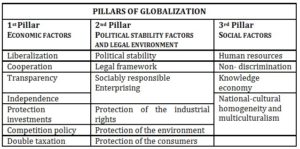
Source: processed by the authors
Referring to the contemporary development of globalization, we suggest definitions of three pillars of globalization comprising the abovementioned factors in three constituted pillars, as presented in table 1. Socially responsible enterprising can also be perceived as a factor of globalization, it is a set of moral and ethical principles. Factors of globalization on macro and micro level, mutually affecting one another contribute with their characteristics to the form of the globalization’s pillars. Economic factors creating the 1st pillar are the result of the nature and orientation of the state’s economy; that means no intervention of the state into economic relations and strengthening the rules of the economic competition. Economic factors cover areas such as cooperation, independence, transparency, protection of the economic competition, taxes, introduction of innovative technology, science and research. Moreover, infrastructure and availability and price of the energy are also included here. Globalization processes have an impact on national and legal regulations, international contracts and agreements of the international organizations (WTO, EÚ). The factors of political stability of the state, the protection of industrial rights and the intellectual property’s rights belong to the 2nd pillar. In addition to the factors underlying the 3rd pillar, i.e. human resources, prohibition of discrimination on grounds of citizenship originality, education, multiculturalism, etc. may be considered as social factors affecting globalization. All in all, all mentioned factors altogether represent the pillars of globalization.
Academic and Practical Approach towards Globalization
In science, we may observe efforts to make the definition of globalization more precise and to reflect better the real connotation of the term “globalization “. It can be understood on the basis of two approaches: the practical and academic approach. From practical point of view, globalization is understood as the better utilization of economic potential for enterprising in the territories of other states, thus, it can be defined as the process of gradual interconnection and convergence of individual national economies and also as the transformation of economies into the new economic structure of national economies. From the academic perspective, the application of scientific disciplines is implemented, in particular, in macroeconomics, international investment law, European integration and international economic relations. These disciplines address the processes and relations related to the process of globalization and form the basic principles of globalization. Several major legal institutes supporting globalization processes development have been derived from the application practice knowledge, such as non – discrimination, the most – favored – nation clause, proper implementation of the economic competition rules and State aid rules. Countries’ willingness and support for cross-border trading enabled by proper legislation result in an increasing economic activity. Moreover, if a country can produce goods or services at lower relative costs than other countries, which is comparative advantage, the country should invest its financial resources to the production of those particular goods or services. The actual export flows reveal the country’s strong sectors, it is also known in the classical economic theory as Revealed Comparative Advantage. Balassa’s (1965) well-known index of “revealed comparative advantage” was based on the Ricardian model whose predictions had been that “countries should produce and export relatively more in industries in which they are relatively more productive.” (Costinot, Donaldson, Komunjer, 2012). It confirms why Slovakia produces and exports in automotive industry. In Slovakia, as a result of globalization and the growth of automobile industry, the education and training system has changed proving high quality of labor force in the variety of specific areas related to the automotive industry.
General Characteristics of the Global Enterprise
The global business entity is considered an economic subject operating in the territories of several states. The transnationality and ability to adapt to the conditions of the host state are considered the basic features of the global enterprise. The primary factor in achieving business competitiveness is highly efficient management, which needs to have a dynamic and flexible management structure enabling to realize rapid changes and information sharing. In global businesses, the gap between “domestic” and “foreign” managers disappears, as people from all over the world have to communicate and cope with cultural diversity. The roles of most managers are of an international nature and require balancing the need for a response to local requirements from a global perspective. It must be able to connect international diversity with the national environment, create synergies of cultures and promote international cooperation and trade. The role of a global enterprise is to achieve world-class production processes. The business activity of global corporations is exposed to various financial risks: market risk (currency and price risks), credit risk and liquidity risk. Global risk management focuses on unpredictable financial market developments and minimizes potential negative impacts on its financial situation. Risks are managed at the consolidated level by the parent company of a global enterprise. Individual units under the leadership of the legal department of global enterprise identify the individual risks which are reported to the parent company, applying agreed on criteria. The latest issues of global businesses and efforts to solve them are systemized up in table 2.
Table 2: Global Enterprises nowadays
Source: Processed by authors
Job preservation, employment sustainability, performance-based remuneration, employee system, staff qualifications, and further training are the priorities of human resource management. At present, global businesses are trying to keep their environmental and energy impacts at the lowest level, complying with the valid legal regulations in the field of environment protection. They motivate their employees to be active in saving energies. The global enterprise needs the stabilization of its employees and other priorities such as stable working places, qualifications, advantages of skilled employees. They also have a significant place in the field of introducing new technologies, science, education and employment. By their nature, they are
Table 3: Global players in automotive industry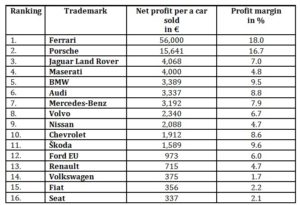
Source: Adapted by authors based on (Bloomberg, 2017)
multinational companies that engage in economic activity in various countries and are traded on international markets. It is illustrated by the fact that there are many car manufacturers in the world, but not all manufacturers achieve the expected profits and profitability e.g. Volkswagen or Ford. Bloomberg has now published a car-branding list by profit per car. Table 3 highlights a) the profit per a car and b) profit margin percentage for a selected car trademarks.
Globalization and Openness of the Slovak Economy in Automotive Industry
The automotive industry is a major player in the European economy accounting for 6.4% of GDP and contributing to 2.3 million jobs in the European Union (EU). However, it has been facing difficulties as a result of the economic crisis. (European Parliament. 2016). An entire automotive industry in Slovakia has a strong tradition and became the most important sector and driver of the economy. Over the past 20 years it has been an important source of foreign direct investment. The successes may be demonstrated by the following accomplishments: a) 80,000 people employed directly by the 3 car producers — VW, PSA, Kia & Tier 1suppliers; b) 200,000 employees (direct or indirect) are in the automotive industry; c) the share of the automotive industry is 43% of the total industrial production; this production represents 35-percent share on the total industrial export of Slovakia; that means that the automotive industry generates 17 billion € of industrial export and 2.5 billion € in added value. The successful Slovak car production by manufacturers and suppliers is illustrated in table 4, 5 figure 1, 2.
Table 4: Car production in Slovakia in the period of 2005-2015 and the forecast for the 2020
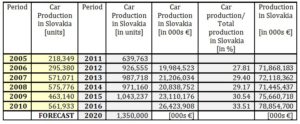
Source: Elaborated by the authors (Sario, 2016), (2017)
Nowadays, Slovakia belongs to the 20 biggest car producers in the world and produces more cars than Italy and Poland combined (SARIO, 2016) as shown in table 5: in 2015, the car production per capita and the forecast for the year 2020. In addition, for example, Slovak’s foreign trade in 2016 grew considerably a) by €1,443.4 million of passenger cars and other motor vehicles and their exported parts; b) by €424.3 million of components and exported accessories (Ministry of Economy SR, 2016).
Table 5: Car production per 1000 inhabitants

Source: processed by the authors (SARIO, 2016).
Three crucial automotive producers together with a well-developed and high–quality supplier network contribute to the success of the Slovak automotive industry. There is a high demand for the products manufactured by Tier–1–2 suppliers and they are exported to factories located across Europe and overseas locations.
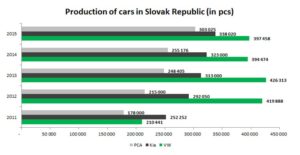
Fig. 1: Car production by PSA Slovakia, KIA Motors Slovakia and VW Slovakia.
Source: (IPDAP, 2016)
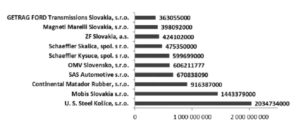
Fig. 2: Largest suppliers in 2016 based on the sales revenues in EURO.
Source: (IPDAP, 2017)
The level of globalization and the openness of the economies of states are measured by selecting suitable indicators. We have selected a rating based on the KOF index. Globalization Index KOF 2016 measures the three main dimensions of globalization, i.e. economic, social and political ones. Globalization is defined for this index as the process of creating networks of connections among actors at multi-continental distances, mediated through a variety of flows including people, information and ideas, capital and goods, (Statistics Authority, 2016). It is obvious that the globalization index is different for individual states. The selected indicators determine the real status of globalization in the rated states in 2016. Slovakia ended in the 16th position from 192 states evaluated, that can be considered a positive fact referring to the length of being the sovereign state since 1993. Slovakia also achieved 12th place in the assessment of the economic globalization index where the actual flows, trade, foreign direct investment, stocks, portfolio investment, restrictions and taxes on international trade were taken into account. The part of social globalization rating was created by data on personal contact, telephone traffic, transfers (percentage of GDP), international tourism, foreign population, international letters, data on information flows, internet users, television, newspapers trade, and data on cultural proximity. Slovak Republic‘s ranking was the 20th position. Political globalization index included the information on membership in international organizations, international treaties, and embassies in the country for evaluation. The Slovak Republic moved up to 44th place. The best rating was achieved by Netherlands (91.7), Ireland (91.64), and Belgium (90.51).
Table 6: Globalization Index KOF 2016
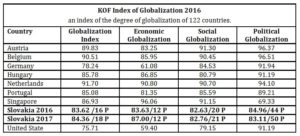
Source: Elaborated by the authors (Swiss Federal Institute of Technology, 2017)
Results for Slovakia for the years 2016 and 2017 are included in table 6, which enables comparision and shows a slight worsening for Slovakia in the globalization index, caused by the worse result in political globalization. The top three 2017 results achieved in KOF globalization index (out of 122 countries) are as follows: Globalization index: 1. Netherland – 92.84, 2. Ireland – 92.15, 3. Belgium – 91.75; composed of Economic globalization: 1. Singapore – 97.77, 2. Ireland – 94.65, 3. Luxemburg – 94.06; and Social globalization: 1. Singapore – 91.61, 2. Switzerland – 91.13, 3. Ireland – 90.99; and finally Political globalization: 1. France – 97.21, 2. Italy – 97.25, 3. Belgium – 95.79.
Accomplished Globalization Benefits in the Automotive Industry in Slovakia
Transnational corporations gain state aid and benefits that favor their entrepreneurship allowing them to reduce their cost at the expense of competitive businesses. The state aid grant is compatible with the common European market because the balance is guaranteed between the resulting distortion of competition and the benefits of the aid. In addition to state aid, which is provided mainly for the purpose of regional development, the institute of major investments is also applied in accordance with Slovak legislation, the Act no. 175/1999 which considers major investments an establishment to be used for production, the development of which shall be organized by a resident legal entity, as long as: a) the funds necessary for the development of the establishment achieve not less than 1 billion SKK of capital investments (30,126 SKK/1€); b) the expected volumes of production and employment are material in the context of the national economy, and c) the Slovak Government decides that the implementation of the project would be in the public interest (Act No. 175/1999. Art. 1.2). State aid is defined as an advantage in any form whatsoever conferred on a selective basis to undertakings by national public authorities (European Commission. 2017). Article 107(1) TFEU defines state aid as any aid granted by a member state or through state resources in any form whatsoever which distorts or threatens to distort competition by favoring certain undertakings or the production of certain goods so far as it affects trade among member states. Regarding the Article 107(1) TFEU, generally the state aid rules only apply where the recipient of an aid is an “undertaking”, (European Commission. 2014). It is necessary to take into consideration the institute of the advantage of improving the position of the competitor on the market. An advantage, within the meaning of Article 107(1) TFEU, is any economic benefit that would not be obtained by an entity under normal market conditions, i.e. in the absence of state intervention. Neither the cause nor the objective of the state intervention is relevant, but the crucial is the effect of the measure on the business entity. Investors coming to Slovakia are attracted by the state aid instruments, but this is not the only reason for entering the Slovak market. The first major foreign investor in Slovakia was the German company that entered the Slovak market as Volkswagen Bratislava, Ltd. since 1991 and later the joint stock company VOLKSWAGEN SLOVAKIA Inc. (since 1998). The various forms of the state aid and allowances provided to the company are presented in table 7. The main subject of the company’s economic activity is manufacture and assembly of vehicles and their parts, manufacture of gearboxes and components. Sales of products are generally carried out within the Volkswagen Group.
Table 7: Volkswagen Slovakia, a.s. benefits received
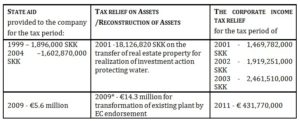
*Legend: capital obtained is for the VW’s investment project aimed at diversifying the output and increased the production capacity of the plant in Bratislava.
Source: processed by authors (Reports SA, 2005), (EC 2012)
Another multinational trading company that is active in the automobile industry is the PSA Peugeot Citroën Groupe, (Peugeot Citroën Automobiles Slovakia, Ltd. in 2003, since 2006 PSA Slovakia, Ltd.) The strategic investment of the French investor in 2003 amounted to €700 million, (PSA Annual report, 2008). The total investment of the PSA Peugeot Citroën group in Slovakia has exceeded €1billion. On 18 March 2004, in Bratislava, Kia Motors Corporation and the Slovak Republic officially approved the construction
Table 8: Granted State Aid
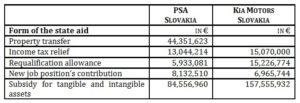
Source: (Ministry of Economy SR, 2017)
of the first European Kia car factory in Slovakia with signing the contract between Kia Motors Corporation and the Slovak Republic. In table 8, the volumes of state aid granted to both companies are shown. From an economic point of view, the arrival of another transnational corporation means the investment of €1.7 billion capital. Their economic activity has contributed to economic development, employment growth and export increase. Multinational businesses such as PSA Slovakia, Ltd. and KIA Slovakia, Ltd. state aid or other financial benefits recipients in the form of subsidies for employee training, etc. The following table demonstrates selective 2015 financial results achieved by these car manufacturers.
Table 9: Financial Data of the Three Car Producers in 2015

Source: (Finstat, 2017)
In 2015, VOLKSWAGEN SLOVAKIA Inc. increased net earnings to 127.5 billion which is 3% increase, and sales grew by 17% to €7.227 billion. In 2015, PCA Slovakia Ltd. cut its profit by 9% to 26.96 mil € and sales grew by 17% to €2.449 billion. In 2015, Kia Motors Slovakia s.r.o. cut its profit by 26% to €210.1 million and sales increased by 11% to € 5.073 billion (Finstat, 2017).
Table 10: Selected Business Data

Source: processed by the authors (Finstat, 2017)
The Government of the Slovak Republic has granted the major investments to multinational companies operating in the automobile industry; they gained a competitive advantage and a better market position. These business companies have a major macroeconomic importance, social importance and importance for regional development. The significance of FDI is reflected in the increased economic activity of the population, the eradication of poverty in the region, the increase in consumption, and the increase of household incomes thanks to global corporations in the automotive industry operating in Slovakia as a consequence of globalization. The remuneration for the company’s business results is paid to all rate tariff employees. The amount of remuneration depends on the company’s management in the given year. Employees share the company’s success in this way. In the near future the investment of Jaguar Land Rover is expected to even expand considerably the automotive suppliers’ network, also to the central and eastern parts of the state which are the regions below 75% of the GDP average of the average of EU member states. The threat may be for the Slovak economy advocated by the critics of globalization – small economy overdependence. For instance, small states, as Slovakia, depend so much on larger corporations and large international corporations are powerful enough to dictate operation terms (a threat to relocate the production) or indirectly to obtain more favorable conditions related to the taxes and buying the land at a bargain price, etc. More than 300 suppliers marked successful operations in Slovakia in years 2014-2016.
Table 11: Top Ten Plants in Sales Revenues and Creating Jobs for the Suppliers (Tier-3) in Slovakia
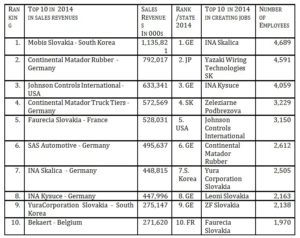
Source: Elaborated by the authors (SARIO, 2016)
Table 12: Selected Average Financial Indicators for the Suppliers (Tier-3)

Source: Processed by the authors (Finstat, 2016)
In October 2017 there were 111,000 people employed in the automotive industry (Figure 3 – producers and suppliers Tiers 1, 2, 3 and others). The high and steadily increasing productivity in the automotive industry

Fig.3: New jobs in Slovakia created by Automotive Industry in 2016
Source: (IPDAP, 2017).
in Slovakia resulted in changing the status of the production in this industry, which is not classified as low cost anymore. In spite of that, it remains cost–competitive on the regional and European level. The Slovak labor force is known for its flexibility, excellent qualification and high productivity.
Conclusion
One cannot forget the fact that international organizations are also considered to be actors of globalization. Globalization is an unstoppable process that will continue to influence the political, economic, social and cultural relations of the states. The recent decades have manifested powerfully a globalization of consumption also in new emerging markets, Visegrad Group countries are not exceptions, “fed by the expansion of the internet, peoples’ increased international mobility and persuasive hedonistic pressure in the media. The recent economic crisis changed consumer shopping habits and behavioral patterns in many countries and resulted in new post-crisis consumer trends”, (Mroz, 2016, p.361).
There is no doubt that globalization in the automobile industry has a positive impact on the Slovak economy and on economic growth. It has a positive effect in the area of employment policy, as the automobile industry is the largest employer in Slovakia, with positive effects on regional development, new subcontracting relationships and pro-export policy. Our contribution is the theoretical clarification of the concept of the globalization pillars and a global enterprise and systemization of their highlighted problems. The research should be continued as we see the room now for it in verifying these theoretical assumptions and functioning of the global enterprises in the real life and testing the problems of the global enterprises and their effective solving. We stress that the global business must be able to connect international diversity with the national environment, protect the environment and create synergies of cultures, promote international cooperation and trade and protect the variety of customers’ and entrepreneurs’ rights in accordance with the concept of globalization pillars. For international investors we emphasize that Slovakia is attractive for the foreign investors due to the following characteristics: a) the highest labor productivity in the CEE region, b) strategic location in Europe with great export potential, c) cost-effective & skilled labor force, d) political & economic stability, e) wide supplier network in automotive industry f) growing R&D centers & innovation network , g) Euro currency as one of a few in CEE , h) attractive investment incentives i) fastest growing Eurozone member within the last 10 years for automotive industry j) well-developed infrastructure.
By Studying and analyzing the phenomena of globalization, the following arguments may be concluded: Firstly, globalization has rapidly influenced economic policy in Slovakia and the automobile industry in Slovakia began developing. Transnational corporations operating in the automobile industry increasingly expand their production and increase the export. Foreign investors are clearly involved in the removal of regional disparities, in the creation of subcontracting relations and in the exports increase. The new era of globalization is also marked by social responsibility and environmental protection. Automobile companies in Slovakia are fully aware of these trends. Foreign subsidiaries have also emerged as sub-suppliers, which has a positive impact on employment policy. Slovak suppliers are taking a bigger role in the globalization process.
Secondly, globalization in the automobile industry has affected regional development and the Slovak labor market. The economic operators receiving state aid and state aid have had to create new jobs. As a result of the inflows of investors in the automobile industry, the structure of the labor market and the education process in Slovakia also changed. The state aid and investment incentives are provided when investment is aimed at a lagging region, below 75% of GDP p.c. of the EU average. In the end, regional GDP increases alike the living standard of the population, narrowing regional disparities.
At last, the globalization of the automobile industry means an increasing dependence of the Slovak economy on foreign investors and transnational capital movements. The disadvantage of the global economy is that the profits of wealthy trading companies are concentrated at the headquarters of the company. Globalization has also caused companies from advanced economies to use cheaper labor markets for their manufacturing activities. Small and medium-sized enterprises have become suppliers to multinational companies. The suppliers have been required to form their own strategies. An effect of this is that suppliers increasingly have to actively understand and foresee technological changes in order to be prepared for disruptions of their existing businesses. Those companies which will master that will be prepared to face the changes caused by the technological or other global progress in the production of hybrid or electromobiles or intelligent transport.
(adsbygoogle = window.adsbygoogle || []).push({});
References
- Asanuma, B. (1989),´Manufacturer–supplier relationships in Japan and the concept of relation-specific skill,´ Journal of the Japanese and International Economies, 3(1), 1–30.
- Balassa, B. (1965), ´Trade Liberalization and Revealed Comparative Advantage´, In: The Manchester School of Economic and Social Studies, 33, 99-123.
- Chang,, Kaltani , L., and Loayza N.V., (2009), ´Openness can be good for growth: The role of policy complementarities´, Journal of Development Economics 90, pp. 33–49.
- Costinot, A. Donaldson, D. and Komjuter, I., (2012),´What Goods Do Countries Trade. A Quantitative Exploration of Ricardo’s Ideas, ´ Review of Economic Studies, Vol. 79, pp. 581–608 doi: 10.1093/restu,d/rdr033, Oxford University Press
- Cusumano, M. A., and Takeishi, A., (1991),´Supplier relations and management: A survey of Japanese, Japanese-transplant, and U.S. auto plants,´ Strategic Management Journal, 12(8), 563–588.
- Daniels, J. D., Radebaugh, L. H., & Sullivan, D. P. (2015). International business: environments and operations. Boston: Pearson.
- Dohse, K., Jurgens, U., and Malsch, T. (1985), ´From “Fordism” to “Toyotism?” The social organization of the labor process in the Japanese automobile industry,´ Politics & Society, 14(2), 115–146.
- Dreher, A. Gaston, N., and Martens, P. (2008), ´Measuring Globalization – Gauging its Consequence´, New York:
- Dreher, A., (2006), ´Does Globalization Affect Growth? Empirical Evidence from a new Index.´Applied Economics, https://ideas.repec.org/a/taf/applec/v38y2006i10p1091-1110.html
- Global Production Networking and Technological Change in East Asia. The World Bank and Oxford University Press. Washington. DC.
- Ishida, S., Magnusson, M., and Nagahira, A., (2017), ´Factors influencing Japanese auto suppliers’ predictions about the future of new technologies – An exploratory study of electric vehicles´, Futures, 89, 38-59. doi:10.1016/j.futures.2017.03.009
- Kher, HV., Kydd, CT., and Obrien, TM., (2017), ´Evolution of product quality in European, Japanese and US automotive firms: An exploratory longitudinal analysis,´ Omega, 73, 29-36. doi:10.1016/j.omega.2016.12.003
- Liker, JK., (2004), ´The Toyota Way: 14 management principles from the world’s greatest manufacturer.´ New York, NY: McGraw-Hill.
- Lin, G., (2001), ´Globalization of the automobile industry in China´, CICERO, Working Paper. p. 7 https://www.duo.uio.no/bitstream/handle/10852/32767/1381.pdf?sequence=1
- Mróz, B. (2016). Post-crisis consumer trends in Poland. International Journal of Economic Policy in Emerging Economies, 9(4), 361. doi:10.1504/ijepee.2016.10002395
- Nishiguchi, T., (1994), ´Strategic industrial sourcing.´ New York: Oxford University Press.
- Peráček, T., Nosková, M. and Mucha, B. (2017), ´Selected issues of Slovak business environment´, Economic and social development-“Managerial issues in modern business” (Book of Proceedings) Varazdin : Varazdin development and entrepreneurship agency, 254-259.
- Sako, M., & Helper, S., (1998), ´Determinants of trust in supplier relations: Evidence from the automotive industry in Japan and in the United States.´ Journal of Economic Behavior & Organization, 34(3), 387–417.
- Saxunova, D., (2015), ‘Innovative financing mechanisms in global environment.’ In: Globalization and its socio-economic consequences: part 2. – Žilina : University of Žilina, 2015. – p. 642-652.
- Silvianita, A., & Tang, C. (2017), A Model Linking the Knowledge Management (KM) Enabler, KM Capability and Operational Performance in Indonesian Automobile Industry. Advanced Science Letters, 23(1), 640-642. doi:10.1166/asl.2017.7281
- T.J. and Lester. R.K. (2004). ‘The new global supply-base: New challenges for local suppliers in East Asia’ in Shahid. Y.. Anjum. A.M. and Nabeshima. K. (Eds):
- Ulici, I., Dorle N., and Campean, S.M. (2016). The effects of Globalization in the car industry. Arhipelag XXI Press, Tîrgu Mureș, http://www.upm.ro/gidni3/GIDNI-03/Soc/Soc%2003%2085.pdf
- Walters, M., (2001). ´Globalization.´ 2nd edition Routledge Publishers.
- Womack, J. P., Jones, D. T., & Roos, D. (1990). The machine that changed the world: Based on the Massachusetts Institute of Technology 5-million-dollar 5-year study on the future of the automobile. New York: Rawson Associates.
- Analyza automobiloveho priemyslu 2016-17, (2017), [Online], [Retrieved June 22, 2017], http://www.ipdap.sk/
- Sario, (2016), Automotive Industry Association of the Slovak Republic (ZAP SR), [Online], [Retrieved June 22, 2017], http: //www.sario.sk
- European Parliament, (2016), Motor vehicles. New approval and market surveillance rules, [Online], [Retrieved June 22, 2017], http: //www.europarl.europa.eu/RegData/etudes/ BRIE/2016/577978/EPRS_ BRI(2016)577978_EN.pdf
- European Commission, (2017), What is State aid? [Online], [Retrieved June 22, 2017], http://ec.europa.eu/competition/state_aid/overview/index_en.html
- Europsen Commision, (2014), Draft Commission Notice on the notion of State aid pursuant to Article 107(1) TFEU, [Online], [Retrieved June 22, 2017], http://ec.europa.eu/competition/consultations/2014_ state_aid_notion/draft_guidance_en.pdf
- European Commission, (2009), State aid: Commission endorses €14.3 million aid for Volkswagen in Bratislava, Slovakia. [Online], [Retrieved July 22, 2017], .http://europa.eu/rapid/press-release_IP-09-1865_en.htm
- FINSTAT, (2017), VOLKSWAGEN. a.s., [Online], [Retrieved June 22, 2017], https://www .finstat.sk/35757442) .
- FINSTAT,(2017), PCA Slovakia. s.r.o. [Online], [Retrieved June 22, 2017], https://www.finstat.sk/36256013
- FINSTAT, (2017), Kia Motors Slovakia s.r.o. Ekonomické informácie o spoločnostiach [Online], [Retrieved June 22, 2017], https://www.finstat.sk/35876832
- IPDAP, (2016), Slovak Automotive Industry Development, [Online], [Retrieved June 22, 2017], http://www.ipdapgroup.com/en/2016/11/21/slovak-automotive-industry-development-2015/
- KOF globalization index, (2016), [Online], [Retrieved September 22, 2017], http://globalization.kof.ethz.ch/media/filer_public/2016/03/03/rankings_2016.pdf
- Ministry of Economy of the Slovak Republic (2017). Foreign Trade 2016. [Online], [Retrieved June 6, 2017], http://www.economy.gov.sk/12354-menu/147744s
- PSA – Slovakia 2017: Správa http://www.psa-slovakia.sk/novinky-1/kratke-spravy/trnavska-automobilka-psa-groupe-slovakia-zvysuje-mzdyhtml?page_id=2443 https://www.finstat.sk/35757442
- PSA Slovakia, (2008), Annual Report, [Online], [Retrieved June 22, 2017], http://www.psaslovakia.sk/buxus/docs//dokumenty/Vyrocna_sprava_2008.pdf)
- PSA Slovakia, (2016), [Online], [Retrieved September 22, 2017], http://www.psa-slovakia.sk/o-psa-slovakia.html?page_id=172
- Vláda SR, (2009), Návrh na poskytnutie investičnej pomoci pre spoločnosť KIA Motors Slovakia. [Online], [Retrieved June 22, 2017], http://www.rokovania.sk/Rokovanie.aspx/BodRokovania Detail?idMaterial=9202

















